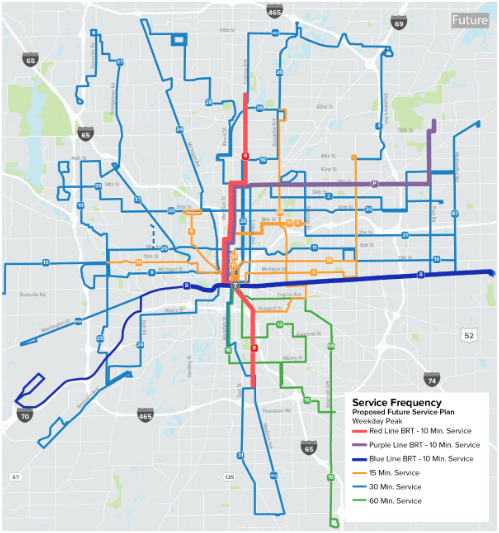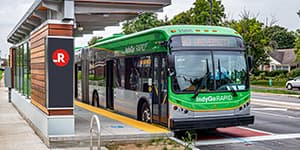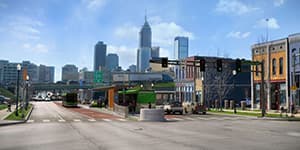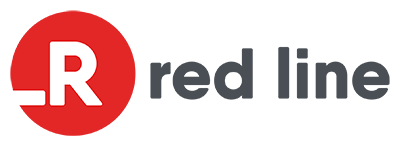Overview
IndyGo remains committed to offering fast and reliable bus service. Our public outreach efforts enable us to understand our riders’ needs better. Learn more about IndyGo’s Public Involvement Program HERE.
Every five years, IndyGo will look to conduct a comprehensive operational analysis (COA) and an onboard rider survey with smaller studies in between. This means that the next COA and OBS would likely conclude in 2027. For more information about IndyGo’s onboard rider survey, click here.
Below are summaries of IndyGo’s more recent planning efforts. To learn more about what is currently in progress, click here.
2020-2022 Review of IndyGo’s Network Redesign & Creation of the 2027 Transit Network
In 2020, though much of the agency’s efforts were focused on responding to the pandemic that was unfolding then, the IPTC Board of Directors approved IndyGo staff to move forward with its next comprehensive operational analysis (COA) to review the network redesign. Many of the original milestones and deadlines established in the 2016 Marion County Transit Plan had come to pass, and many of the assumptions about ridership and revenue had already begun to change. IndyGo needed to develop a new set of milestones for the implementation of IndyGo’s local route improvements.
The process of reviewing the network redesign began in early 2021. Community stakeholders reinforced the need for a transit network that offers frequent, reliable, and accessible public transportation. Similar to what was done in April 2020, IndyGo staff were able to make another set of strategic adjustments to its future service plan. Check back soon to learn more about this process.

To see a higher resolution image of the map shown above, click HERE.
June 2020 Network
Throughout 2019 and into 2020, IndyGo attended 19 different community events to meet with community stakeholders interested in informing the major service changes that were planned for June 2020. Over 230 unique comments aimed at the proposed changes. Each was reviewed by IndyGo staff who used the community’s feedback to make the first set of strategic adjustments to the 2016 Marion County Transit Plan. A key takeaway from these engagements was the community’s renewed commitment to transition IndyGo’s hub-and-spoke system into a more frequent, more connected grid-based system. The June 2020 network was adopted by the IPTC Board of Directors on April 23, 2020, replacing the 2016 version of the Marion County Transit Plan.
During the same meeting, the emerging COVID-19 pandemic caused the IPTC Board of Directors to have to approve an emergency response plan to reduce IndyGo’s service, which caused the implementation of the June 2020 service changes to be put on hold indefinitely.
To view an index of the unique comments that IndyGo received during this process, click HERE.
To learn more about our public outreach efforts leading up to the adoption of the June 2020 network, click HERE.
To view a map of the June 2020 network that was never fully implemented, click HERE.
To view the report of the conducted outreach for the individual route changes that did take place in June 2020, click HERE.
2016 Central Indiana Transit Plan Survey & the Introduction of the Marion County Transit Plan
The 2016 Central Indiana Transit Plan Survey helped to establish the seven demands of transit riders as determined by the Central Indiana community. More recent customer surveys and feedback obtained during community engagement events tell us that these things still hold true today.
- It takes me where I want to go.
- It takes me when I want to go.
- It is good use of my time.
- It is a good use of my money.
- It respects me in the level of safety, comfort, and amenity it provides.
- I can trust it.
- It gives me the freedom to change my plans.
The Marion County Transit Plan (MCTP) – In 2014, Indiana passed legislation to enable a stable and dedicated funding source for transit investments via a public referendum process. It allowed six central Indiana counties to ask for voter approval for a local income tax that funded transit within that county, following the development of a document outlining how revenue dollars would be spent. The plan that voters voted to approve was the original MCTP, developed after hundreds of hours of public input and technical transit planning. The cornerstone of the plan was marketed improvements to local bus service and the introduction of bus rapid transit service. The implementation of this plan began even before the passing of the local tax referendum by the City-County Council in 2016, with the decision to design and build the Red Line even if the referendum funding failed voter approval.
Updated several times since, IndyGo continues to make progress on the implementation of the MCTP. Here’s what’s already been implemented:
- Every route now operates seven days a week.
- The first of three new BRT routes, the Red Line, launched on September 1, 2019.
- IndyGo achieved a 38% increase in service (prior to COVID-19).
- Service frequency increased on Routes 3, 5, 6, 8, 10, 30, 31, 34, 37, 39 and 87.
- New buses were purchased, and old ones were retired.
- IndyGo added new staff to expand operational and administrative capabilities.
- The MyKey fare system was developed and launched.
- IndyGo rolled out the first all-electric bus rapid transit route.





